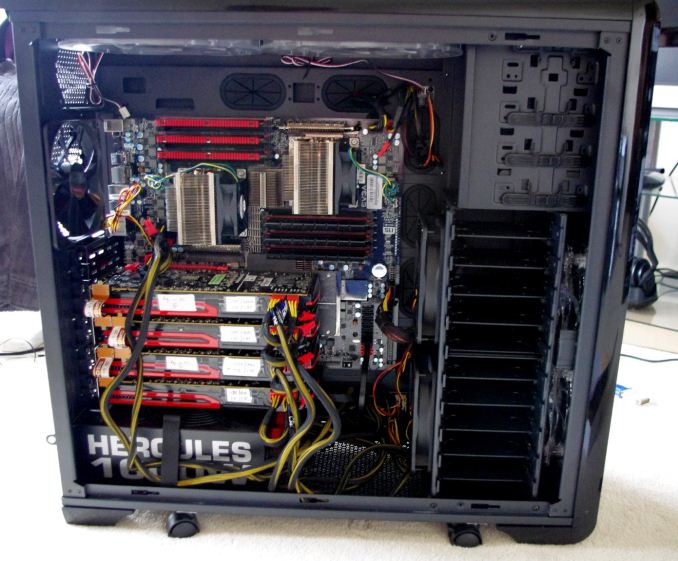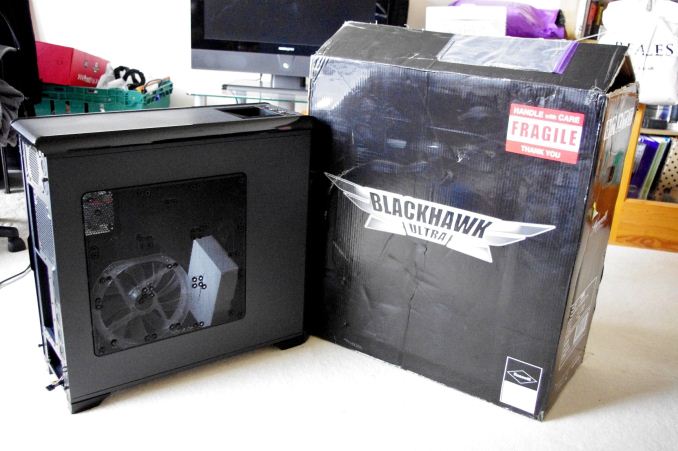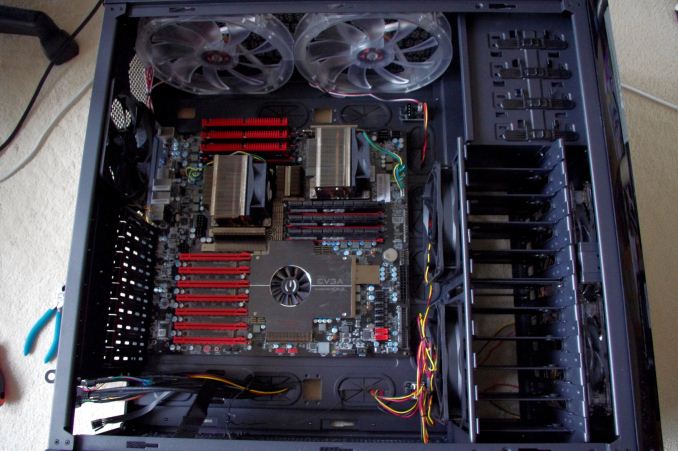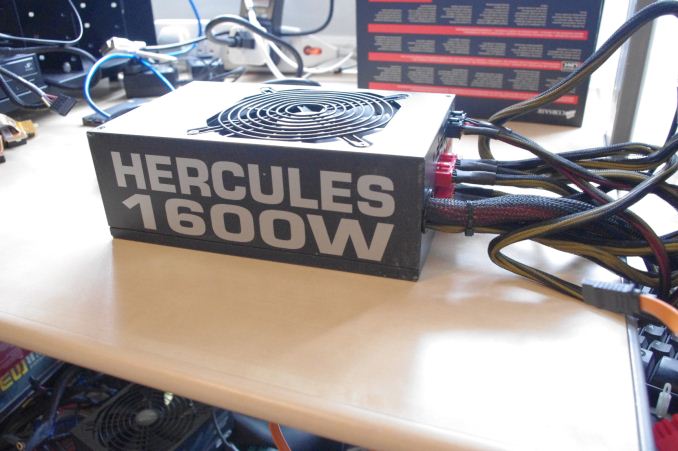Choosing a Gaming CPU: Single + Multi-GPU at 1440p, April 2013
by Ian Cutress on May 8, 2013 10:00 AM ESTTo start, we want to thank the many manufacturers who have donated kit for our test beds in order to make this review, along with many others, possible.
Thank you to OCZ for providing us with 1250W Gold Power Supplies.
Thank you to G.Skill for providing us with the memory kits.
Thank you to ASUS for providing us with the AMD GPUs and some IO Testing kit.
Thank you to ECS for providing us with the NVIDIA GPUs.
Thank you to Corsair for providing us with the Corsair H80i CLC.
Thank you to Rosewill for providing us with the 500W Platinum Power Supply for mITX testing, a BlackHawk Ultra, and 1600W Hercules PSU for extreme dual CPU + quad GPU testing, and RK-9100 keyboards.
Thank you to Gigabyte for providing us with the X5690 CPUs.
Also many thanks go to the manufacturers who over the years have provided review samples which contribute to this review.
Testing Methodology
In order to keep the testing fair, we set strict rules in place for each of these setups. For every new chipset, the SSD was formatted and a fresh installation of the OS was applied. The chipset drivers for the motherboard were installed, along with NVIDIA drivers then AMD drivers. The games were preinstalled on a second partition, but relinked to ensure they worked properly. The games were then tested as follows:
Metro 2033: Benchmark Mode, two runs of four scenes at 1440p, max settings. First run of four is discarded, average of second run is taken (minus outliers).
DiRT 3: Benchmark Mode, four runs of the first scene with 8 cars at 1440p, max settings. Average is taken.
Civilization V: One five minute run of the benchmark mode accessible at the command line, at 1440p and max settings. Results produced are total frames in sets of 60 seconds, average taken.
Sleeping Dogs: Using the Adrenaline benchmark software, four scenes at 1440p in Ultra settings. Average is taken.
If the platform was being used for the next CPU (e.g. Maximus V Formula, moving from FX-8150 to FX-8350), there's no need to reinstall. If the platform is changed for the next test, a full reinstall and setup takes place.
How to Read This Review
Due to the large number of different variables in our review, it is hard to accurately label each data point with all the information about that setup. It also stands to reason that just putting the CPU model is also a bad idea when the same CPU could be in two different motherboards with different GPU lane allocations. There is also the memory aspect to consider, as well as if a motherboard uses MCT at stock. Here is a set of labels correlating to configurations you will see in this review:
CPU[+][(CP)] (PCIe version – lane allocation to GPUs [PLX])
First is the name of the CPU, then an optional + identifier for MCT enabled motherboards. (CP) indicates we are dealing with a Bulldozer derived CPU and using the Core Parking updates. Inside the parentheses is the PCIe version of the lanes we are dealing with, along with the lane allocation to each GPU. The final flag is if a PLX chip is involved in lane allocation.
Thus, for example:
A10-5800K (2 – x16/x16): A10-5800K with two GPUs in PCIe 2.0 mode
A10-5800K (CP) (2 – x16/x16): A10-5800K using Core Parking updates with two GPUs in PCIe 2.0 mode
FX-8350K (2 – x16/x16/x8): FX-8350 with three GPUs in PCIe 2.0 mode
i7-3770K (3/2 – x8/x8 + x4): i7-3770K powering three GPUs in PCIe 3.0 but the third GPU is using the PCIe 2.0 x4 from the chipset
i7-3770K+ (3 – x16): i7-3770K (with MCT) powering one GPU in PCIe 3.0 mode
i7-3770K+ (3 – x8/x8/x8/x8 PLX): i7-3770K (with MCT) powering four GPUs in PCIe 3.0 via a PLX chip
Common Configuration Points
All the system setups below have the following consistent configurations points:
- A fresh install of Windows 7 Ultimate 64-bit
- Either an Intel Stock CPU Cooler, a Corsair H80i CLC or Thermalright TRUE Copper
- OCZ 1250W Gold ZX Series PSUs (Rosewill 1600W Hercules for The Beast)
- Up to 4x ASUS AMD HD 7970 GPUs, using Catalyst 13.1
- Up to 2x ECS NVIDIA GTX 580 GPUs, using GeForce WHQL 310.90
- SSD Boot Drives, either OCZ Vertex 3 128GB or Kingston HyperX 120GB
- LG GH22NS50 Optical Drives
- Open Test Beds, either a DimasTech V2.5 EasyHard or a CoolerMaster Test Lab
AMD Configurations
A6-3650 + Gigabyte A75-UD4H + 16GB DDR3-1866 8-10-10
A8-3850 + ASRock A75 Extreme6 + 16GB DDR3 1866 8-10-10
A8-5600K + Gigabyte F2A85-UP4 + 16GB DDR3-2133 9-10-10
A10-5800K + Gigabyte F2A85-UP4 + 16GB DDR3-2133 9-10-10
X2-555 BE + ASUS Crosshair V Formula + 16GB DDR3 1600 8-8-8
X4-960T + ASUS Crosshair V Formula + 16GB DDR3-1600 8-8-8
X6-1100T + ASUS Crosshair V Formula + 16GB DDR3-1600 8-8-8
FX-8150 + ASUS Crosshair V Formula + 16GB DDR3-2133 10-12-11
FX-8350 + ASUS Crosshair V Formula + 16GB DDR3-2133 9-11-10
FX-8150 + ASUS Crosshair V Formula + 16GB DDR3-2133 10-12-11 + CP
FX-8350 + ASUS Crosshair V Formula + 16GB DDR3-2133 9-11-10 + CP
Intel Configurations
E6400 + MSI i975X Platinum + 4GB DDR2-666 5-6-6
E6700 + ASUS P965 Commando + 4GB DDR2-666 4-5-5
Celeron G465 + ASUS Maximus V Formula + 16GB DDR3-2133 9-11-11
i5-2500K + ASUS Maximus V Formula + 16GB DDR3-2133 9-11-11
i7-2600K + ASUS Maximus V Formula + 16GB DDR3-2133 9-11-11
i3-3225 + ASUS Maximus V Formula + 16GB DDR3-2400 10-12-12
i7-3770K + Gigabyte Z77X-UP7 + 16GB DDR3-2133 9-11-11
i7-3770K + ASUS Maximus V Formula + 16GB DDR3-2400 9-11-11
i7-3770K + Gigabyte G1.Sniper M3 + 16GB DDR3-2400 9-11-11
i7-3930K + ASUS Rampage IV Extreme + 16GB DDR3-2133 10-12-12
i7-3960X + ASRock X79 Professional 16GB DDR3-2133 10-12-12
Xeon X5690 + EVGA SR-2 + 6GB DDR3 1333 6-7-7
2x Xeon X5690 + EVGA SR-2 + 9GB DDR3 1333 6-7-7
The Beast
The Beast is a special machine put together to help with the review as a result of various hardware coming into my possession all at the same time. The core of the system is an EVGA SR-2 motherboard, the best and last dual processor motherboard to deal with overclockable Xeon processors. This is paired with a couple of X5690 Xeon processors, the highest clocked Westmere Xeon that Intel offers, and many thanks to Gigabyte for loaning these to us for a pair of reviews. I went and purchased a pair of Intel Xeon socket 1567 coolers for the system, which have a 2U z-height restriction but are copper piped and cooled by powerful (and loud) delta fans. These provided enough cooling power to push the Xeons from 3.43GHz to 4.6GHz during some overclocking attempts, so are more than adequate for the job at hand (if you can put up with the noise).
Our system is paired with some high quality DDR3 Hyper memory, once famed for its overclocking prowess but due to frequent deaths from high voltage, is now relegated as a memory for overclockers. However at stock this memory performs great, often in the region of DDR3-2000 C7, so our memory kits are well primed for this setup.
Of course a full system is nothing without a case and power supply to help justify a build. With the motherboard being absolutely huge, no standard case would take it – only large cases designed for desktop-based server 2P motherboards are adequate. Luckily there is one case which is selling well, and Dustin reviewed recently – the Rosewill Blackhawk Ultra. Aside from the weight, this case had no issues with installing the motherboard; it could easily fit in another 10 HDDs, four optical bays, and any major GPU setup you could possibly think of – with plenty of fans just for good measure. Read Dustin’s review for a more thorough analysis, but I have some good shots of the system and motherboard installed for you:
Rosewill also has the perfect power supply for dealing with a dual processor, quad CrossFireX setup. First, consider how many connections this 2P setup needs – we have a normal 24-pin ATX connector for the motherboard, one 8-pin CPU power connector for each CPU, an additional 6-pin PCIe power connector for each CPU to provide extra power, another 6-pin PCIe power connector to provide power to the PCIe slots, and then two 6+2 PCIe power connectors for the GPUs. That makes 11 PCIe connectors needed in total, and this is alongside all the fans in the case and whatever SSD/ODD setup a user wants. The power supply used for this monster is the 1600W Hercules, rated 80PLUS Silver. With access to 16 PCIe connectors, the only way you might need any more is with a compute rig having seven single slot cards each needing two connectors. With the CPUs and GPUs both overclocked, our system was drawing almost 1500W at the wall (at a 240V source) under a high CPU+GPU load.
Using a 2P system as a desktop comes with its own set of issues, namely some CPU benchmarks not optimized for 2P, or in this case, some trouble getting some games to even work. It seems that the more money you can throw at a gaming system the more problems start to arise, but The Beast provides a nice comparison point when we look at high-end Ivy Bridge, Sandy Bridge-E and Piledriver processors in multiple-GPU setups.
Our first port of call with all our testing is CPU throughput analysis, using our regular motherboard review benchmarks.
































242 Comments
View All Comments
JarredWalton - Wednesday, May 8, 2013 - link
"While I haven't programmed AI..." Doesn't that make most of your other assumptions and guesses related to this area invalid?As for the rest, the point of the article isn't to compare HD 7970 with GTX 580, or to look at pure CPU scaling; rather, it's to look at CPU and GPU scaling in games at settings people are likely to use with a variety of CPUs, which necessitates using multiple motherboards. Given that in general people aren't going to buy two or three GPUs to run at lower resolutions and detail settings, the choice to run 1440p makes perfect sense: it's not so far out of reach that people don't use it, and it will allow the dual, triple, and quad GPU setups room to stretch (when they can).
The first section shows CPU performance comparison, just as a background to the gaming comparisons. We can see how huge the gap is in CPU performance between a variety of processors, but how does that translate to gaming, and in particular, how does it translate to gaming with higher performance GPUs? People don't buy a Radeon HD 5450 for serious gaming, and they likely don't play games.
For the rest: there is no subset of games that properly encompass "what people actually play". But if we're looking at what people play, it's going to include a lot of Flash games and Facebook games that work fine on Intel HD 4000. I guess we should just stop there? In other words, we know the limitations of the testing, and there will always be limitations. We can list many more flaws or questions that you haven't, but if you're interested in playing games on a modern PC, and you want to know a good choice for your CPU and GPU(s), the article provides a good set of data to help you determine if you might want to upgrade or not. If you're happy playing at 1366x768 and Medium detail, no, this won't help much. If you want minimum detail and maximum frame rate at 1080p, it's also generally useless. I'd argue however that the people looking for either of those are far less in number, or at least if they do exist they're not looking to research gaming performance until it affects them.
wcg66 - Wednesday, May 8, 2013 - link
Ian, thanks for this. I'd really like to see how these tests change even higher resolutions, 3 monitor setups of 5760x1080, for example. There are folks claiming that the additional PCIe lanes in the i7 e-series makes for significantly better performance. Your results don't bare this out. If anything the 3930K is behind or sometimes barely ahead (if you consider error margins, arguably it's on par with the regular i7 chips.) I own an i7 2700K and 3930K.Moon Patrol - Wednesday, May 8, 2013 - link
Awesome review! Very impressed with the effort and time put into this! Thanks a lot!It be cool if you could maybe somewhere fit an i7 860 in somewhere over there. Socket 1156 is feeling left out :P I have i7 860...
Quizzical - Wednesday, May 8, 2013 - link
Great data for people who want to overload their video card and figure out which CPU will help them do it. But it's basically worthless for gamers who want to make games run smoothly and look nice and want to know what CPU will help them do it.Would you do video card benchmarks by running undemanding games at minimum settings and using an old single core Celeron processor? That's basically the video card equivalent to treating this as a CPU benchmark. The article goes far out if its way to make things GPU-bound so that you can't see differences between CPUs, both by the games chosen and the settings within those games.
But hey, if you want to compare a Radeon HD 7970 to a GeForce GTX 580, this is the definitive article for it and there will never be a better data set for that.
JarredWalton - Wednesday, May 8, 2013 - link
Troll much? The article clearly didn't go too far out of the way to make things GPU bound, as evidenced by the fact that two of the games aren't GPU bound even with a single 7970. How many people out there buy a 7970 to play at anything less than 1080p -- or even at 1080p? I'd guess most 7970 owners are running at least 1440p or multi-monitor...or perhaps just doing Bitcoin, but that's not really part of the discussion here, unless the discussion is GPU hashing prowess.Quizzical - Wednesday, May 8, 2013 - link
If they're not GPU bound with a single 7970, then why does adding a second 7970 (or a second GTX 580) greatly increase performance in all four games? That can't happen if you're looking mostly at a CPU bottleneck, as it means that the CPU is doing a lot more work than before in order to deliver those extra frames. Indeed, sometimes it wouldn't happen even if you were purely GPU bound, as CrossFire and SLI don't always work properly.If you're trying to compare various options for a given component, you try to do tests that where the different benchmark results will mostly reflect differences in the particular component that you're trying to test. If you're trying to compare video cards, you want differences in scores to mostly reflect video card performance rather than being bottlenecked by something else. If you're trying to compare solid state drives, you want differences in scores to mostly reflect differences in solid state drive performance rather than being bottlenecked by something else. And if you're trying to compare processors, you want differences in scores to mostly reflect differences in CPU performance, not to get results that mostly say, hey, we managed to make everything mostly limited by the GPU.
When you're trying to do benchmarks to compare video cards, you (or whoever does video card reviews on this site) understand this principle perfectly well. A while back, there was a review on this site in which the author (which might be you; I don't care to look it up) specifically said that he wanted to use Skyrim, but it was clearly CPU-bound for a bunch of video cards, so it wasn't included in the review.
If you're not trying to make the games largely GPU bound, then why do you go to max settings? Why don't you turn off the settings that you know put a huge load on the GPU and don't meaningfully affect the CPU load? If you're doing benchmarking, the only reason to turn on settings that you know put a huge load on the GPU and no meaningful load on anything else is precisely that you want to be GPU bound. That makes sense for a video card review. Not so much if you're trying to compare processors.
JarredWalton - Wednesday, May 8, 2013 - link
You go to max settings because that's what most people with a 7970 (or two or three or four) are going to use. This isn't a purely CPU benchmark article, and it's not a purely GPU benchmark article; it's both, and hence, the benchmarks and settings are going to have to compromise somewhat.Ian could do a suite of testing at 640x480 (or maybe just 1366x768) in order to move the bottleneck more to the CPU, but no one in their right mind plays at that resolution with a high-end GPU. On a laptop, sure, but on a desktop with an HD 7970 or a GTX 580? Not a chance! And when you drop settings down to minimum (or even medium), it does change the CPU dynamic a lot -- less textures, less geometry, less everything. I've encountered games where even when I'm clearly CPU limited, Ultra quality is half the performance of Medium quality.
IndianaKrom - Friday, May 10, 2013 - link
Basically for the most part the single GPU game tests tell us absolutely nothing about the CPU because save for a couple especially old or low end CPUs, none of them even come close to hindering the already completely saturated GPU. The 2-4 GPU configurations are much more interesting because they show actual differences between different CPU and motherboard configurations. I do think it would be interesting to also show a low resolution test which would help reveal the impact of crossfire / SLI overhead versus a single more powerful GPU and could more directly expose the CPU limit.Zink - Wednesday, May 8, 2013 - link
You should use a DSLR and edit the pictures better. The cover image is noisy and lacks contrast.makerofthegames - Wednesday, May 8, 2013 - link
Very interesting article. And a lot of unwarranted criticism in the comments.I'm kind of disappointed that the dual Xeons failed so many benchmarks. I was looking to see how I should upgrade my venerable 2x5150 machine - whether to go with fast dual-cores, or with similar-speed quad-cores. But all the benchmarks for the Xeons was either "the same as every other CPU", or "no results".
Oh well, I have more important things to upgrade on it anyways. And I realize that "people using Xeon 5150s for gaming" is a segment about as big as "Atom gamers".